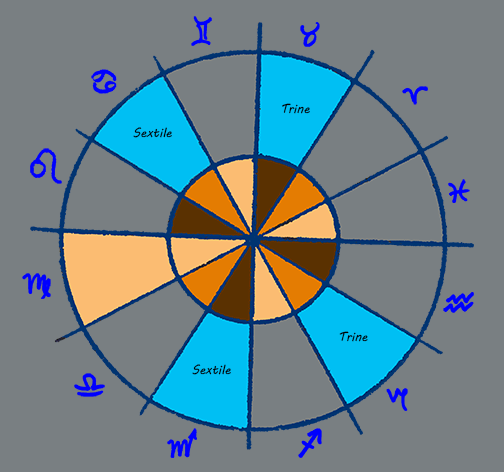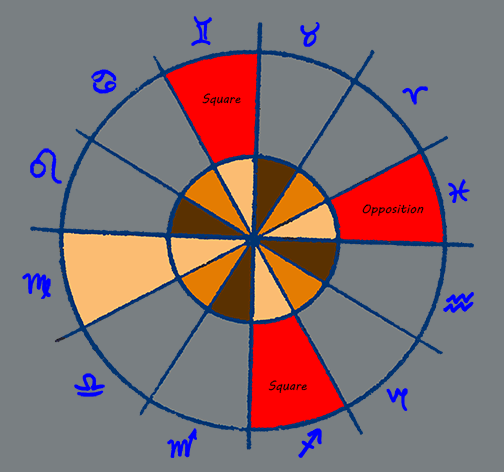Aspects describe angular relationships between points, planets, and signs. The number of aspects varies depending whether one is committed to the the modern approach or the traditional/ancient approach to aspects. The traditional approach uses the ancient aspect set developed by Ptolemy. The Ptolemaic set—used here—consists of the following aspects: sextile, square, trine, opposition and conjunction. The conjunction while technically not an aspect—but rather, a conjoining of planets within a sign—is usually included in most discussions about aspects. However, we won’t review conjunctions during this discussion.
Aspects describe a range of degrees, as follows:
The sextile aspect is 60 degrees between points, planets, or signs
The square is 90 degrees between points, planets, or signs
The trine is 120 degrees between points, planets, or signs
The opposition is 180 degrees between points, planets, or signs
For the diagrams below, I’ve removed the house numbers in favor of signs, and I’ve presented the aspects in relation to the Ascendant, which is occupied by Virgo. However, aspects can occur between planets and points in any sign and in either direction. The important thing to remember:
Aspects occur between planets and points in signs, not houses.
The square is 90 degrees between points and the opposition is 180 degrees.
The sextile aspect is 60 degrees between points and the trine is 120 degrees .
Sextile and Trine
Each sign on the chart is composed of 30 degrees, so any planet or point 60 degrees— three signs—from any other planet or point in either direction is a sextile. Any point 120 degrees—five signs—from any other planet or point in either direction is a trine. So, Virgo to Scorpio is a sextile; Taurus to Virgo is a trine; Sagittarius to Aquarius is a sextile; Gemini to Libra is trine, and so on.
Square and Opposition
The same is true for the square and the opposition; any point 90 degrees—four signs—from any other planet or point in either direction is a square, and any point 180 degrees—seven signs—from from any other planet or point is an opposition. So, Virgo and Pisces is an opposition. Leo and Aquarius is an opposition. Cancer and Capricorn is an opposition.
Remember, aspects are made between signs, so rather than counting degrees, just identify the sign a planet is in and count the signs. Once you have established the aspect relationship, you can then drill down and look at the degrees. We check the degrees to find how close the aspects are between the planets. The closer the aspect, the more impactful the effect.
For example: The Moon at 1 degree Cancer in a sextile aspect to Mercury at 1 degree Virgo is more impactful than if Mercury is at 12 degrees of Virgo.
The Good and the Bad
The aspects have good and bad qualities. The sextile and the trine are good; the square and opposition are bad. It is unfortunate to have to refer the aspect qualities as good/bad because the quality is really more about the ease and difficulty planets have expressing their purest state when interacting with other planets. Sextiles and trines make things happen easily; there’s a flowing friendliness associated with these aspects, and that’s a good thing. Squares and oppositions do not make things happen easily. These two are referred to as ‘hard aspects’; there’s resistance and, as the name implies, opposition. And this is generally considered a bad thing. However, as with most things astrological, it is never that easy or simple.
For now, you can generate your birth chart online or with a charting software or app and find the aspect relationship between planets as described above. Combine this with the information about angles to get a feel for what is happening in your chart. Pay particular attention to planets at, near, and in the AS, MC, DS, and IC positions. If you don’t have planets in these positions. Use the strength of the houses information given previously to find where your planets are in relation to these points.


